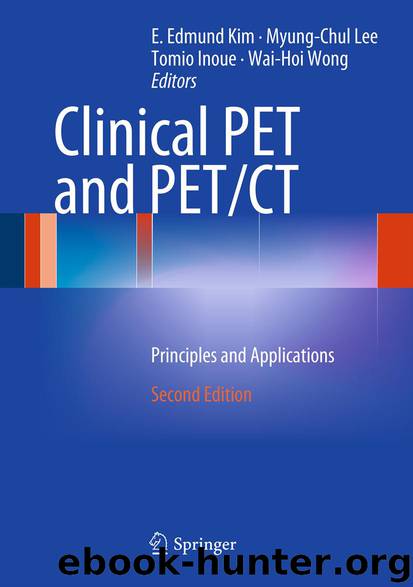Clinical PET and PETCT by E. Edmund Kim Myung-Chul Lee Tomio Inoue & Wai-Hoi Wong

Author:E. Edmund Kim, Myung-Chul Lee, Tomio Inoue & Wai-Hoi Wong
Language: eng
Format: epub
Publisher: Springer New York, New York, NY
An early study has suggested that reduced FDG uptake after treatment appeared to coincide with a decline in the number of viable tumor cells [67]. A decline in 18F-FDG uptake during chemotherapy was significantly associated with a clinical response and survival [28, 68]. SUV may be helpful in the evaluation of the response to therapy. A significant reduction in SUV after therapy would be a good response. Tissue inflammation in response to radiotherapy may lead to false-positive results. Normal variants of 18F-FDG uptake in head and neck locations may also pose difficulty in interpreting images. So, there is no fixed quantitative scheme to use SUV to differentiate cancerous tissue from noncancerous tissue. Therefore, it is particularly important to have a baseline PET/CT scan to help differentiate incidental physiologic 18F-FDG-avid foci from malignant foci on subsequent posttreatment scans.
The timing of PET/CT after therapy is very crucial for accurate assessment of treatment response. The metabolic activity of residual viable tumor might be decreased immediately after the completion of radiation therapy, and it may take several weeks to recover their metabolic activity. Additionally, inflammation caused by radiation may result in diffuse increased FDG uptake, which can impair the identification of residual tumor. A report noted an improvement in both sensitivity and specificity of 18F-FDG PET when the scan was obtained at 8 weeks, as compared with 4–8 weeks, after the end of chemoradiotherapy. A false-positive or false-negative result on 18F-FDG PET/CT did not occur later than 8 weeks after radiation therapy [69]. A recent study has the consensus opinion that PET/CT should be performed about 10–12 weeks after the end of therapy [70].
Download
This site does not store any files on its server. We only index and link to content provided by other sites. Please contact the content providers to delete copyright contents if any and email us, we'll remove relevant links or contents immediately.
| Automotive | Engineering |
| Transportation |
Whiskies Galore by Ian Buxton(41879)
Introduction to Aircraft Design (Cambridge Aerospace Series) by John P. Fielding(33064)
Small Unmanned Fixed-wing Aircraft Design by Andrew J. Keane Andras Sobester James P. Scanlan & András Sóbester & James P. Scanlan(32743)
Craft Beer for the Homebrewer by Michael Agnew(18140)
Turbulence by E. J. Noyes(7936)
The Complete Stick Figure Physics Tutorials by Allen Sarah(7307)
Kaplan MCAT General Chemistry Review by Kaplan(6867)
The Thirst by Nesbo Jo(6826)
Bad Blood by John Carreyrou(6552)
Modelling of Convective Heat and Mass Transfer in Rotating Flows by Igor V. Shevchuk(6391)
Learning SQL by Alan Beaulieu(6211)
Weapons of Math Destruction by Cathy O'Neil(6143)
Man-made Catastrophes and Risk Information Concealment by Dmitry Chernov & Didier Sornette(5921)
Digital Minimalism by Cal Newport;(5664)
Life 3.0: Being Human in the Age of Artificial Intelligence by Tegmark Max(5474)
iGen by Jean M. Twenge(5366)
Secrets of Antigravity Propulsion: Tesla, UFOs, and Classified Aerospace Technology by Ph.D. Paul A. Laviolette(5309)
Design of Trajectory Optimization Approach for Space Maneuver Vehicle Skip Entry Problems by Runqi Chai & Al Savvaris & Antonios Tsourdos & Senchun Chai(5011)
Pale Blue Dot by Carl Sagan(4912)
